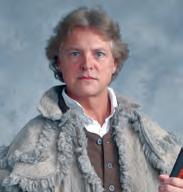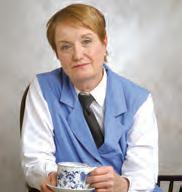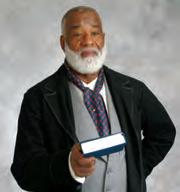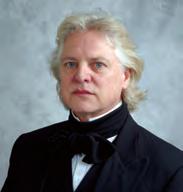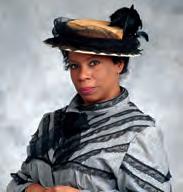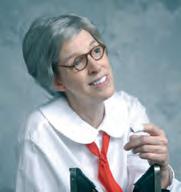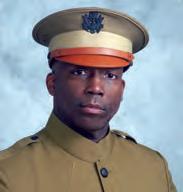
roud to Partner with Kentucky Humanities on Think History , weekdays at 8: 31 a.m. and 7 :1 9 p.m . on 88.9 FM and weku.org.


roud to Partner with Kentucky Humanities on Think History , weekdays at 8: 31 a.m. and 7 :1 9 p.m . on 88.9 FM and weku.org.





Board of Directors
Chair:
Brian Clardy, Ph.D. Murray
Vice Chair:
Jennifer Cramer, Ph.D. Lexington
Secretary/Treasurer:
Clarence E. Glover Louisville
Chelsea Brislin, Ph.D. Lexington
Selena Sanderfer Doss, Ph.D. Bowling Green
Ben Fitzpatrick, Ph.D. Morehead
Nicholas Hartlep, Ph.D. Berea
Sara Hemingway Owensboro
Eric Jackson, Ph.D. Florence
Lois Mateus Harrodsburg
Keith McCutchen, D.M.A. Frankfort
Thomas Owen, Ph.D. Louisville
Jordan Parker Lexington
Libby Parkinson Louisville
Penelope Peavler Louisville
Lou Anna Red Corn, JD Lexington
Andrew Reed Pikeville
Judy Rhoads, Ed.D. Owensboro
Ron Sheffer, JD Louisville
Hope Wilden, CPFA Lexington
Bobbie Ann Wrinkle Paducah
Wayne G. Yates Princeton Staff
Bill Goodman Executive Director
Kathleen Pool Associate Director
Marianne Stoess Assistant Director
Katerina Stoykova
Kentucky Book Festival Director
Zoe Kaylor
Kentucky Chautauqua Coordinator
Derek Beaven Program & Administrative Assistant
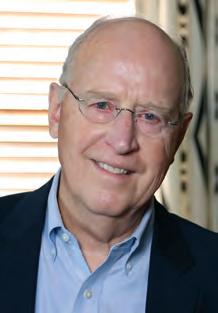 Bill Goodman Executive Director Kentucky Humanities
Bill Goodman Executive Director Kentucky Humanities

One of my favorite ways to deliver the humanities to people across the Commonwealth is Kentucky Humanities magazine. These pages provide the opportunity to tell Kentucky’s stories—some of well-known figures from Kentucky history, others are more recent history, stories you may not yet be familiar with. These stories make up the unique tapestry that is our shared history and culture.
Kentucky native Tula Pendleton was a talented writer with a broad range many authors would envy. Her writing career was blossoming when in 1924, Tula and her husband, Holmes Cummins, Jr. carried out a suicide pact. Not long after, Tula and her writing were forgotten. Tula’s great-niece Barbara Pendleton Jones is shining a light on Tula in her new book Tula Pendleton: The Life and Work of a Forgotten Southern Writer. Linda Elisabeth LaPinta gives us insights on Jones’s book on page 8.
On a November 1887 afternoon in downtown Lexington, thousands of spectators were gathered for the dedication of a statue honoring John C. Breckinridge. The festive mood would soon be marred by a shootout resulting in injury and death. On page 10, author Stuart Sanders shares the story of the feud between Lewis Baldwin and Thomas Marshall Green and how the resulting shootout was typical of the violence in Kentucky in the 19th century.
When celebrating Kentucky’s literary heritage, often lost in the discussion are Kentucky’s Black writers. The Commonwealth’s literary legacy includes an outstanding crop of poets and writers who are Black. Among them is the first African American to publish a novel, William Wells Brown. David Cooper tells us more about some of the talented Black writers who have called Kentucky home beginning on page 14.
Cora Wilson Stewart is an important part of Kentucky history, yet remains often overlooked. Stewart, the founder of adult education, developed “Moonlight Schools” in attempt to irradicate adult illiteracy in Kentucky. On page 17, fellow Kentucky author Kim Michele Richardson tells us more about the woman known as The Moonlight Lady.
In the 18th century, health seekers flocked to mineral spring located near Blue Licks Battlefield State Resort Park. Amateur archaeologist Dennis Vesper purchased the land in 2021 and went on to uncover astonishing archaeological finds. Beginning on page 20, Linda Elisabeth LaPinta shares the remarkable story of the historical findings.
Was he a con man? A wandering horse tamer? Or was he a gifted horse whisperer? Opinions widely varied where Kentuckian Denton Offutt was concerned. Author David McCormick gives us a look at the complicated man on page 25.
Lastly, on page 30 Georgia Green Stamper shares the remarkable story of Vice Admiral Willis A. Lee, Jr. The Natlee, Kentucky, native was a member of the 1920 U.S. Olympic Rifle Team, winning seven medals for the team. That is just a small part of his story. You definitely want to read more.
I hope you enjoy this issue of Kentucky Humanities and I encourage you to spend some time reviewing our 2023 Report to the People found in the center of this magazine. We are proud of the work we accomplished in 2023 and are grateful to all of you have supported us on the journey.


Listen online, sign up for our newsletters, and get to know the best little station in the W-H-I-R-L-E-D a little better at

Dr. Nicholas Hartlep and Dr. Eric Jackson were elected to the Kentucky Humanities Board of Directors at the November 2023 Board Meeting. Each will serve a three-year term, with a second three-year term optional. As members of the 23-person volunteer board, Hartlep and Jackson will help set council policies, award project grants to community organizations, and participate in fund-raising to help Kentucky Humanities meet the growing demand for its programs.
Dr. Nicholas Hartlep is the Robert Charles Billings Endowed Chair in Education at Berea College where he chairs the department of education studies.
Prior to his tenure at Berea College, Hartlep chaired the department of early childhood and elementary education at Metropolitan State University, an Asian American and Native American Pacific Islander-Serving Institution (AANAPISI) in St. Paul, Minnesota. While there he also served as the graduate program coordinator.
Hartlep has published 22 books, including What Makes a Star Teacher? Seven Dispositions that Encourage Student Learning which was published by the Association for Supervision and Curriculum Development. His book The Neoliberal Agenda and the Student Debt Crisis in U.S. Higher Education, with Lucille L. T. Eckrich and Brandon O. Hensley was named an Outstanding Book by the Society of Professors of Education.
During his years in academia, Hartlep has received many awards including the John Saltmarsh Award for Emerging Leaders in Civic Engagement by the Association of State Colleges and Universities (AASCU), the Community Engaged Scholarship Award and the President’s Circle of Engagement Award from Metropolitan State University, a Graduate of the Last Decade Award for his prolific writing from the University of Wisconsin at Milwaukee, the University Research Initiative Award from Illinois State University, and a Distinguished Young Alumni Award from Winona State University.
He serves on the boards of the Kentucky Association of Schools Councils, the Kentucky Association of Colleges for Teacher Education, the Korean American Educational Researchers Association, an Advisory Council Member for the Branch Alliance for Educator Diversity, and State Co-Leader for the Kentucky Scholars Strategy Network.
Hartlep earned a bachelor of science degree in elementary education and a master of science in K-12 education from Winona State University, and a Ph.D. in urban education from the


University of Wisconsin at Milwaukee.
A professor of history with more than 30 years of teaching at the university level, Dr. Eric Jackson is a professor of history and Black studies in the Department of History and Geography at Northern Kentucky University, and currently serves as the associate dean of the College of Arts and Sciences. He teaches courses in American and African American history/studies, race relations, and peace studies.
Jackson has published a wide array of books, articles, book reviews, etc., including works in journals such as Africology: The Journal of Pan African Studies , the Journal of African American History, and the Journal of World Peace. His most recent book, An Introduction to Black Studies, published by the University Press of Kentucky in 2023, was the recipient of the 2023 Thomas D. Clark Medallion Award. In addition, Dr. Jackson is a content expert and grant reviewer for the National Endowment for the Humanities, a member of the Grant Professional Association, and a recipient of the Second International World Civility Award from I Change Nations.
Jackson is an active participant in the northern Kentucky community, having served on the boards of the Boone County Public Library, the Kenton County Historical Society, the Kentucky Historic Preservation Review Board, the Boone County Kentucky Historic Preservation Board, the Kentucky African American Heritage Commission, and the Kentucky Civil War Commissions, among many others.
Jackson earned a bachelor of science degree in history from Ball State University, a master of arts in history from the University of Cincinnati, and a Ph.D. from the University of Cincinnati.


On Saturday, February 3, 2024, Kentucky Humanities, in partnership with the University of Kentucky College of Education Center for Professional Development, presented Safe Students, Empowered Educators: Dismantling Hate & Violence in Schools. This educator’s workshop was presented as part of the National Endowment for the Humanities’ United We Stand: Connecting Through Culture initiative.
Safe Students, Empowered Educators was a day-long workshop to reflect on diverse experiences and perspectives and to explore the history of prejudice in hopes of creating a more just society. The workshop was designed to assist educators in combating hate-motivated violence by creating programming that promotes civic engagement, social cohesion, and cross-cultural understanding. Teachers were provided with tools needed to be more confident in advancing justice in the classroom and creating a more just society.
The workshop took place at the University of Kentucky’s Gatton Student Center in Lexington and featured a keynote address by New York Times bestselling author Nic Stone. Stone’s books include Dear Martin, Chaos Theory, and Clean Getaway, among many others. Other sessions included an Opening Plenary with Dr. Christia Spears Brown, who discussed topics from her book Unraveling Bias; Come in from the Cold: Addressing the Chilling Effect of a Politicized Environment on Teacher Speech with Sarah LaCour, Ph.D. and J.D.; Bridging Gaps presented by Marshall Fields, and Developing Racially Responsive Sport Industry Leaders led by Dr. Rasheed Flowers and Dr. Kwame Agyemang.
Registration for the workshop was available to all Kentucky K-12 teachers, school administrators, and teachers in training. The first 200 registrants received a $100 stipend for attending and all who attended received six hours of professional development credit.
Participants who registered prior to November 30th were entered in a drawing for author Nic Stone to visit their school on Friday, February 2, 2024. The school visit included 150 copies of Stone’s book for students. On Friday, Stone visited Tates Creek High School in Lexington to speak to and answer questions from students and to give each student in attendance a signed book.


 Reviewed by
Linda Elisabeth LaPinta
Reviewed by
Linda Elisabeth LaPinta
In 1872, Tula Pendleton was born to John Edward Pendleton, a noted Confederate surgeon, and Ida Emily Nall, a younger sister of John’s first wife, Margaret Nall Pendleton, who had died at age 33. The couple lived in Hartford in Ohio County, and Tula joined a family of five half-siblings, who were also her cousins. John and Ida had another baby soon after Tula’s birth, but he passed away before his second birthday. Jones has reconstructed Tula’s life by scrupulously assessing the few family letters and other primary evidence she could find, thoroughly analyzing ancillary historical documents, and shrewdly identifying the pivotal events in Tula’s life that shaped her. From astute interpretation of her data, Jones has configured a compelling biography.
For example, although far less is known about Tula’s mother than about her publicly praised father, family letters record Ida’s fun-loving, energetic nature that, on Tula’s seventh birthday, as-
sumed the form of an elegant, extravagant party held in her honor. The January 14, 1880, edition of the Hartford Herald described the event as a “Juvenile Masked Ball” replete with “rare edibles” amidst “tropical fruits and flowers” accompanied by dancing that lasted until 1:00 a.m. According to Jones, Ida, with the assistance of two household servants, “was able to paint, write, entertain, and direct amateur theatricals” while raising six children. Jones adds, “All of this ended, however, after her husband died when she was forty-six.” The house that Ida had managed for twentyseven years—the Italianate mansion named Hillside that had been her home—was sold because her husband had left the proceeds to Ida’s stepchildren. Her grief, coupled with her fall from grace, caused Ida to eke out an existence teaching art while residing first in a boarding house in a nearby town and finally returning to Hartford, “perhaps [to] her parents’ old house,” until her death in 1906.
As a child, Tula clearly experienced uncomplicated pleasures and privileges, while also witnessing the misogyny and racism of her era that had repercussions within her own family. She obtained an unusually well-rounded and rigorous education at Hartford College in her later elementary years and then at Richmond Female Institute in Richmond, Virginia, where she earned high marks and recognition on academic honor rolls. And, even as Tula recalled her mother’s having written “weird poetry,” Tula herself turned to her pen to begin writing fiction, mostly short stories.
At age 22 Tula married. No record remains to indicate where the bride and her groom, James Holmes Cummins, Jr., a Memphis insurance executive—who went by his middle name, Holmes—met, but Jones thinks it likely that Tula’s brother-inlaw Harrison Pirtle Taylor introduced them. After a honeymoon tour that included stops in Niagara Falls, New York, Baltimore, and Washington, the couple made Memphis their home.
Apparently, the love match proved happy and hopeful and largely remained so throughout their three-decade union despite disappointments that too often pivoted the couple painfully close to despair. The fact that no children came of the marriage surely served to increase Holmes and Tula’s sorrow, and that blow certainly intensified when their adopted daughter about which little is recorded ran away, never to return. And then there were the moves—so many moves—from one city and state to another, including back to Kentucky for a while. Putting down roots then pulling up stakes for Holmes to remain employed and for the couple to find affordable housing shifted from occasional changes of residence within and among states to a palpably frenetic pattern of relocation akin to migration. But the unkindest cut of all, Holmes’s failing health, caused the couple to find the strength to forge their own fate rather than succumb to a disease for which there was no cure and to surrender to the often-pitiless fate of women without means in the early twentieth century.
Holmes developed acute asthma his physicians could not treat successfully. Temporary improvements in his breathing gave way
to increasingly harrowing bouts of gasping for breath. And after years of fighting for air, when Holmes’s death appeared imminent, he and Tula birthed a plan. They made a pact to commit suicide together, a scheme they carried out.
On the face of it, planning to kill oneself and to do so in the company of another may strike many readers as mad, as evidence of chronic depression or of some other mental state they would label as disordered. That conclusion is common, and Jones admits the possibility of such. But she also paints a much more nuanced and rational assessment of the strength, love, and realistic decision-making ability of a man who could conquer his own illness only by controlling the nature and circumstances of his death and of a woman likely to live the balance of her life in misery should she not have the monetary means to survive. Few fifty-two-year-old (the age at which Tula died) women could find gainful employment in 1924, and, after all, Tula had witnessed what had happened to her mother.
Indeed, Tula’s writing career had ratcheted up as her husband’s illness had kept him from working for increasingly longer periods. Her short stories appeared more and more frequently in national magazines, her earnings no doubt funding household

expenses. Jones has included those tales, some of which reveal Tula’s passion for plot twists, as well as her penchant for such romantic writers as Edgar Allan Poe. Tula’s gift for pulling readers into her tales proved greater than her ability to sustain her stories’ momentum, and her writing about Black characters in the vernacular (even while portraying her Black characters in positive lights, as she invariably did) grates on contemporary sensibilities. Yet, by coupling Tula’s stories with her biography, Jones has not only provided her readers with further evidence of Tula’s abilities and influences; she has brought her great-aunt back to life.
Dr. Linda Elisabeth LaPinta has authored hundreds of magazine and newspaper articles, journal articles, and book reviews, as well as five books published by the University Press of Kentucky. Her most recent book, Kentucky Quilts and Quiltmakers: Three Centuries of Creativity, Community, and Commerce, is the recipient of the Popular Culture Association’s 2024 Emily Toth Award for best single work by one or more authors in Women’s Studies.



 BY FENTON JOHNSON
BY FENTON JOHNSON



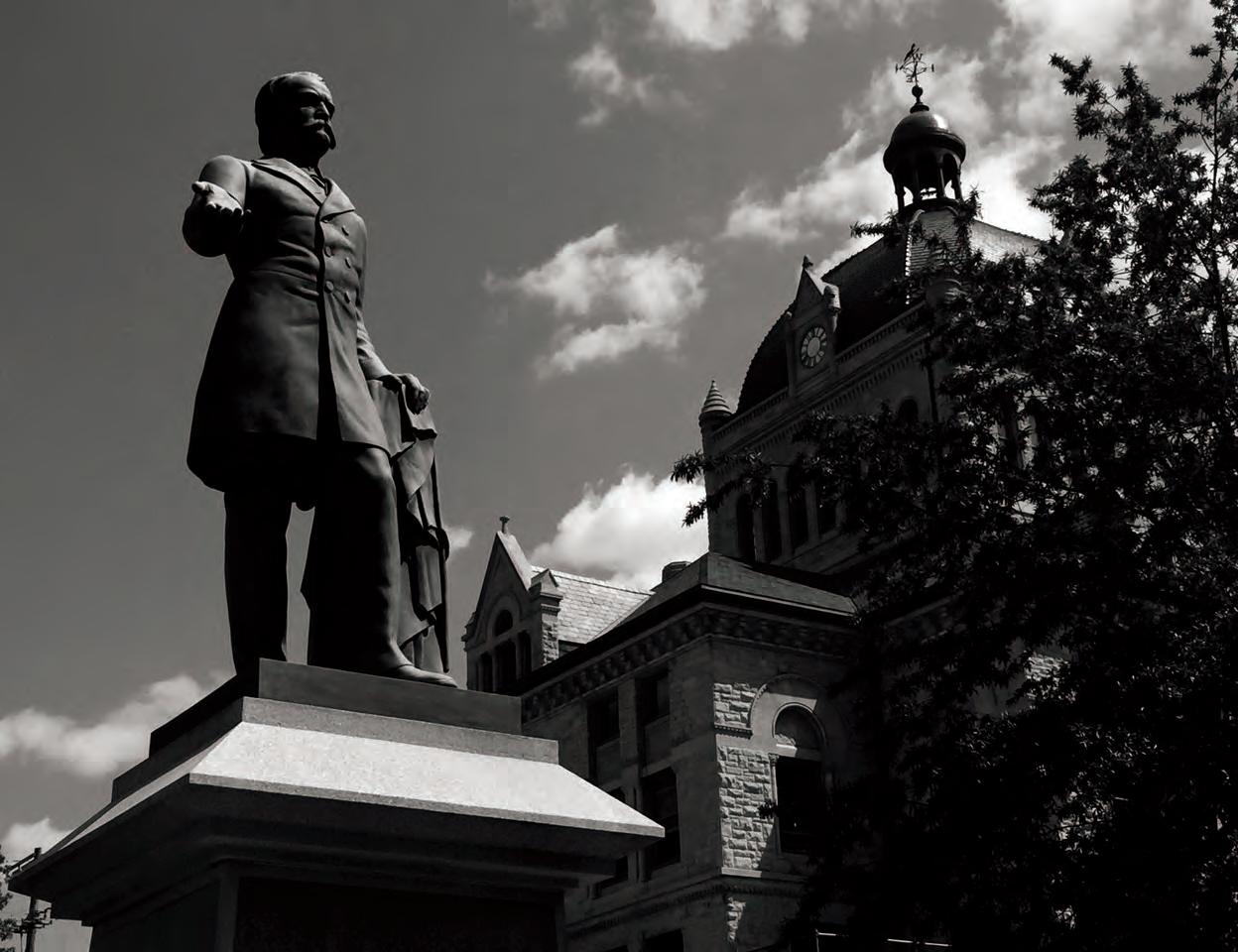 By Stuart W. Sanders
By Stuart W. Sanders
The John C. Breckinridge memorial was built in 1887 and was prepared by New York’s HenryBonnard Bronze Company.
Originally placed on the courthouse lawn in Lexington, the monument was moved to the Lexington Cemetery. It now sits near John C. Breckinridge’s gravesite.
On November 16, 1887, thousands of spectators crowded around the courthouse in downtown Lexington for the dedication of a statue honoring John C. Breckinridge, a Lexington native, former U.S. vice president, and Confederate secretary of war. Although speakers called for reconciliation between the North and South, two people in town that day were not seeking peace. Instead, Thomas Marshall Green and Lewis Baldwin had a shootout that killed one of them, wounded another, and left a spectator injured.
The animosity between Green and Baldwin grew out of several articles that Green had written for the Cincinnati Commercial Gazette linking Baldwin, a Nicholasville public official, to voter fraud. Their fight, however, was not Green’s first brush with interpersonal violence. Born near Danville on November 23, 1836, Green was a Centre College graduate, attorney, and newspaper editor. In 1857, he lost his law license for sending a rival editor a challenge to duel. Five years later, during the Civil War, Green helped negotiate another affair of honor between a Union colonel and a pro-Confederate civilian that led to one duelist’s death.
Therefore, like many upper-class, white, male Kentuckians during the 19th century, Green was not afraid to use weapons to settle conflict. By 1887, however, he was a prominent citizen, known for his speeches, political activism, and work as a journalist. According to the Louisville Daily Journal, Green was “a very accomplished scholar, an able writer, an eloquent and effective speaker, a patriot without the shadow of suspicion, and a man without fear and without reproach, his influence is great.” It was in his role as a newspaper correspondent that tossed this erudite Kentuckian into the firing line.
Located on Main Street, a few blocks from the Lexington Courthouse sat the Phoenix Hotel. On November 16, 1887, around 11:30 a.m. Lewis Baldwin and Thomas Marshall Green drew their weapons and took shots at each other despite the crowd of hundreds surrounding them.



Thomas Marshall Green struck Lewis Baldwin with two bullets. The fatal shot went through Lewis’s aorta. Following his death, spectators carried Lewis’s corpse into the Phoenix Hotel. He was survived by his wife and six children.
In the fall of 1887, Green wrote an article raising suspicion that Baldwin, a circuit court clerk in Jessamine County, was involved in stealing two poll books after an election. Four voters’ names in one of the books, it was alleged, may have been forged. When citizens demanded to examine the books, they disappeared. Green traveled to Nicholasville, the county seat of Jessamine County, and reported on the incident. After Green questioned Baldwin’s role, the clerk wrote a response to the newspaper. Other letters followed, and Green soon raised additional questions about local corruption.
Baldwin, however, had a solid reputation. Born near Winchester on June 26, 1849, he was a prominent Nicholasville attorney, circuit court clerk, and deputy collector of internal revenue. One newspaper described him as “a handsome, brave, manly young man, and was very popular wherever he was known.”
Baldwin believed that Green’s investigation had questioned his integrity and thrown a shadow over his years of public service. After exchanging angry letters with Green, Baldwin traveled to Cincinnati to find the reporter at the newspaper office. When he discovered that Green was not there, he told the staff that “he would fight [Green] with any weapons he might choose from pistols to tooth-picks.” In the end, it would be pistols.
On November 16, Green and Baldwin were both in Lexington for the dedication of the Breckinridge statue. Green’s friends had
told him that Baldwin was in town. Therefore, Green decided “that I had better prepare. I got a pistol from a friend.”
At 11:30 a.m., Green walked up Main Street toward the Phoenix Hotel, located just a few blocks from the courthouse. Nearly 200 people, including Baldwin and several friends, were outside of the hotel waiting for the statue dedication to begin. Upon seeing Green, Baldwin approached the newspaperman and demanded an apology. Green refused. The two men argued, their words growing louder as the crowd cleared away. W. H. Polk, a friend of Baldwin’s, said that he “believed that both men were dead game and would fight as long as they lived.” Neither man was backing down.
Green and Baldwin stepped closer to one another. Baldwin called Green “a liar, a coward, a thief, and a son of a bitch.” Green then turned and walked away, saying “Oh, you can curse me as much as you please, or say what you please to me. You are a blackguard, and I cannot notice you.” Green dismissed Baldwin as an insignificant, lower-class bother, which infuriated Baldwin even more. Baldwin drew his revolver. When Green saw the weapon, he turned, rushed forward, and grabbed Baldwin’s pistol arm. Baldwin broke free and struck Green in the head several times with his weapon. Green staggered back. As he stumbled nearly 10 feet away from Baldwin, he drew his own gun.
Witnesses contradicted one another as to who shot first, because both men fired nearly simultaneously. A flurry of five or
six rounds echoed down the street. W. H. Polk, who had stepped forward to stop the fight, yelled, “For God’s sake, Lewis, don’t shoot; listen to me.” Caught in the crossfire, Polk was shot twice, once by each man. “As I threw up my hand, I heard a shot and felt a stinging sensation in my wrist, and almost instantly another ball hit my left hand,” he said.
Polk was not the only casualty. Baldwin shot Green in the left side. The bullet traveled around his ribs and lodged in his back. Despite the wound, Green shot Baldwin twice in the left shoulder. Baldwin yelled “Oh, my God!” and fell. The second shot, which ranged into his heart, struck him as he lay on the sidewalk. The shooting was over in seconds. Witnesses rushed Green into the Phoenix Hotel. The wounded man also had, a reporter wrote, “received a severe blow from Baldwin’s pistol over the left eye which produced an ugly gash.”
Baldwin lay motionless on the pavement. “I saw that he was beyond all hope and was a dead man,” one witness said. Baldwin died in three minutes. A doctor who examined his corpse concluded that “One wound was below the collar bone, the other about two inches below [the] first, three or four inches above [the] nipple. The lower wound was fatal. The lower ball passed through the aorta.” Among those saddened by Baldwin’s death was W. H. Polk. “I loved him like a brother,” Polk said.
The shooting “caused the wildest excitement” in Lexington. Spectators carried Baldwin’s corpse into the hotel. That evening, it was sent by train to Nicholasville. Baldwin’s funeral procession to the town’s Maple Grove Cemetery included 144 carriages and wagons and nearly four thousand people. He was survived by his wife and six children.
Authorities arrested Green for murder. Interest in the case was widespread, with one reporter noting that the courtroom during his trial was “literally jammed” with spectators. Although witnesses’ testimony often contradicted one another, Green was acquitted of killing Baldwin by reason of self-defense, a typical verdict when educated, white Kentuckians of means were tried for murdering antagonists in street fights after the Civil War.
The fight between Green and Baldwin is emblematic of how some Kentuckians used violence to settle conflict in the years after the Civil War. During the antebellum period, Green and Baldwin likely would have engaged in a formal duel. By the 1880s, however, the prevalence of concealed weapons, and the breakdown of the code of honor that had once formalized dueling, led antagonists to instead engage in impromptu street fights. Green’s shooting of Baldwin was just one of dozens of deadly public encounters that occurred in Kentucky during the late 19th century.
This postwar violence hurt the Commonwealth’s reputation. It also, some journalists and politicians argued, harmed the state’s economy. “The damage that acts of violence in Kentucky do the State outside can not be calculated,” the Bourbon News wrote in 1883. “They deter immigration; they intimidate capital; they make the name of Kentucky a reproach. All sensible men, as well as all
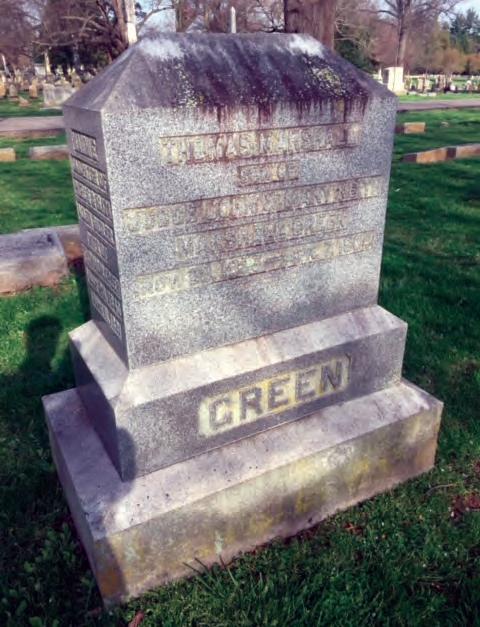
Thomas Marshall Green was arrested for murder but went on to be acquitted of killing Lewis Baldwin by reason of self-defense. Green died in 1904.
good men, should combine to beat down and destroy the swaggering spirit which gives rise to them.” These arguments did little to change Kentucky’s culture, and violence continued throughout the late 19th and early 20th centuries.
Green had been living in Danville since 1872. He returned there after his acquittal and wrote several books, including The Spanish Conspiracy and Historic Families of Kentucky. Green died from diabetes on April 7, 1904. Among those attending his funeral was former U.S. vice president Adlai Stevenson, who had also gone to Centre College. Upon Green’s death, the Boston Globe called him “one of the most widely known historians in the south.” A respected figure at the time of his death, few of Green’s obituaries mentioned that he had killed Lewis Baldwin.
Stuart W. Sanders is the author of five books, including Murder on the Ohio Belle and his latest, Anatomy of a Duel: Secession, Civil War, and the Evolution of Kentucky Violence

 By David Cooper
By David Cooper



Arecently published article in Kentucky Humanities magazine (Spring 2022) pointed out that “Kentucky is blessed with literary wealth.” One often hears of famous Kentucky writers such as Jesse Stuart, Wendell Berry, James Still, Lee Pennington, Hunter S. Thompson, Barbara Kingsolver, Bobbie Ann Mason, and others. But what of Kentucky’s Black writers? Are they invisible like the protagonist in Ralph Ellison’s Invisible Man or are they just conveniently omitted?

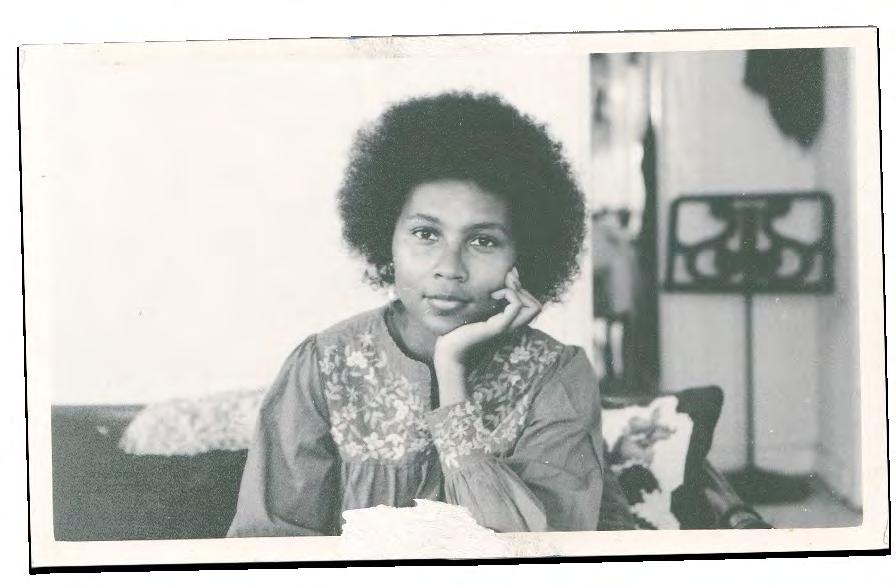
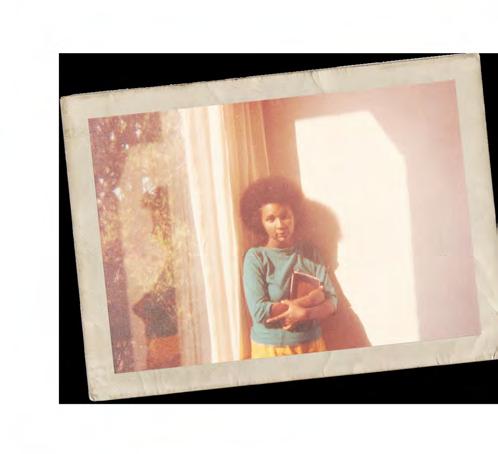

Explore the life and legacy of Kentucky-born author bell hooks, who wrote nearly 40 books and whose work at the intersection of race, class and gender serves as a lasting contribution to the feminist movement. Learn how bell’s childhood in Hopkinsville and her connection to Kentucky’s “hillbilly culture” informed her views and her belief that feminism is for everybody.
Featuring selections read by Academy Award winner Octavia Spencer
Interviews with Gloria Steinem, Crystal Wilkinson, Silas House and Gwenda Motley



Kentucky is also blessed with an outstanding crop of poets and writers who are Black. Going back to the 1800s, William Wells Brown, a runaway slave from Montgomery County, Kentucky, became the first African American to publish a novel, Clotel or The President’s Daughter in 1853. This novel was about a fictional daughter of the third president of the United States, Thomas Jefferson. It was written when the liaison between Jefferson and Sally Hemings was only a rumor. Brown became an abolitionist and published other works, but the novel secured his place in literary history.
The Harlem Renaissance poet, Countee Cullen, was reputedly born in Louisville in 1903. He was brought to New York City by his paternal grandmother, Amanda Porter, when he was nine years old. When she died, the Reverend Frederick A. Cullen and his wife, Carolyn, “adopted” Countee Porter who would become one of the major Harlem Renaissance poets and would be briefly married the daughter of W.E.B. DuBois, Yolande DuBois. Cullen was married (to women) twice although he was gay. Cullen was what Alain Locked called a “New Negro,” urbane, educated, and sophisticated. He earned a master’s degree in English from Harvard. John Keats was the literary role model for Cullen who wrote in the sonnet form.
Cullen published books of poetry: Color, The Black Christ, Copper Sun, The Ballad of the Brown Girl, and On These I Stand
A lesser-known Black Kentucky writer is Joseph Seamon Cotter, Jr. He graduated from Louisville Central Colored High School in 1911. His father was the school’s principal, and his mother was a teacher there. Cotter attended Fisk University in Nashville for two years until tuberculosis forced him to return home. He completed a collection of one-act plays and a book of poetry, Band of Gideon, before he died at age 24 from tuberculosis. It is believed that he was the equal of Cullen, Claude McKay, and Langston Hughes. Who knows what he might have accomplished had his life not been cut short?
Gloria Jean Watkins aka bell hooks was a force of nature, a feminist, and activist. Famed poet Maya Angelou called her “a phenomenal woman.” Born in Hopkinsville, Kentucky, in 1952, Gloria Jean Watkins chose the pen name bell hooks after her maternal great-grandmother, Bell Blair Hooks. She always put the name in lower case to emphasize the importance of her ideas over her personal life. She defied her father by accepting a scholarship to the University of California Santa Cruz, but she completed her odyssey by finishing her career as a professor at Berea College. bell hooks published 40 books, numerous articles, appeared in documentaries, and delivered public lectures. Her work focused on the intersectionality of race, class, gender, and capitalism. She was a small woman who made big trouble, good trouble.
Gayl Jones was born in Lexington, Kentucky in 1949. Her best-known novel, Corregidora, was published when she was just 25 years old. Her second novel, Eva’s Man, received faint praise, but she continued writing. Jones published two collections of
short stories, White Rat (1977) and Raveena (1986) and also published both The Healing (1998) and Mosquito (1999). Jones withdrew from public life after her husband died by suicide in 1998. However, she published Palmares in 2021.
The Affrilachian poets was a major literary movement in Kentucky. The term was coined by poet Frank X Walker to describe African Americans from rural Appalachia. Other poets and writers identified with the movement include Nikki Finney, Kelly Ellis, Paul Taylor, and Crystal Wilkinson. Walker was the executive director of the Governor’s School for the Arts and Poet Laureate of Kentucky from 2013-2015. He was born in Danville, Kentucky, as the second of 11 children. He has published numerous volumes of poetry; Buffalo Dance: The Journey of York won the 2004 Lillian Smith Book Award. He also won a 2014 NAACP Image Award for outstanding literary work.
A native of Casey County, Kentucky, Crystal Wilkinson is also an Image Award winner and former Kentucky Poet Laureate (2021-2023). Wilkinson is the author of Perfect Black (2021) which Ms. magazine described as “a memoir in verse which elegantly explores rural black girlhood, religion, sexual abuse, and growing up in Southern Appalachia” Her other works include The Birds of Opulence, Water Street, and Blackberries, Blackberries In 2024, she published Praisesong for the Kitchen Ghosts: Stories and Recipes from Five Generations of Black Country Cooks. Louisville poet, Hannah Drake is the author of 12 books and is a spoken word or slam poet. Slam poetry is part poetry and part performance which includes audience participation. Her poem, “Formation” “went viral and was shared 20,000 times all over the world.” She is a poet for the computer age; her poems appear on YouTube and X (formerly Twitter). As an activist, Drake’s poetry is about the Black struggle and oppression as well as Black pride. The wealth of the Commonwealth is in its people, in its mountains, in its birds and animals, in its rivers, and in its writers. But what of Kentucky’s writers who are Black? As Countee Cullen wrote a century ago: “Yet I do marvel at this curious thing/To make a poet black and bid him sing.”
David L. Cooper taught English, composition, literature, and African American history at Jefferson Community and Technical College for 37 years. He has also taught at Phillips Academy in Andover, Massachusetts, and for the Kentucky Governor’s Scholars Program. In addition, he received a National Endowment to the Humanities grant to study the Great Black Migration in 1996 and a Ford Foundation grant to study at the Library of Congress in 2003. For several years, Cooper was a reporter for The Courier-Journal. He has published articles in Black Enterprise and Essence magazines. He has also published poetry in The Kentucky Poetry Review, Bluegrass Literary Review, the New Southerner, and Pegasus.
 By Kim Michele Richardson
By Kim Michele Richardson
Sor the firing of a cannon—a war fought with the book and pen, yet this amazing Kentucky teacher didn’t have a proper gravestone, much less a monument that would’ve been given to her if she were a man.
She founded adult education with “Moonlight Schools.” Yet today we hardly know her name. “The Moonlight Lady,” Cora Wilson Stewart, was such an inspiration and left an important footprint that I was inspired to buy her a grave marker 65 years after her death.

A native of Farmers, Kentucky, Cora Wilson Stewart, known as The Moonlight Lady, led the nation’s first official campaign to fight adult illiteracy.
Kentucky labors under stereotypes of backwardness but deserves to be known for its unsung initiatives and profound movements like the Packhorse Librarian Project or the Frontier Nursing Service, which were women-driven and saved lives of those living in abject poverty in eastern Kentucky.
But when researching my latest book, I dug deeper into an even more obscure, but wildly successful literacy campaign founded by a Kentucky woman known as The Moonlight Lady. She was such an inspiration and left an important footprint that I was inspired to buy her a grave marker 65 years after her death, an unsettling reminder of how far women have come and how much further we need to go.
On September 5, 1911, Cora Wilson Stewart (1875-1958) opened her first Moonlight School in Rowan County, Kentucky. That first night 1,200 adults showed up. They came in droves from Kentucky’s dark hollers, needle-eyed coves, and tree-thick hills. Born in Farmers, Kentucky, Stewart led the nation’s first official campaign to fight adult illiteracy.
Many attendees of the Moonlight Schools were coal miners, lumber workers, or farmers by day. The adult students became known as Moonlighters and would walk miles to class on nights
when the moon was bright enough to light the dark, tricky paths. They attended the eight-week session during the bone-shivering winters, green carpeted springs and sticky hot summers. Their ages ranged from 18 to 86. Some walked with canes, others toted babies after a long day’s work, many chanting along the paths a favorite poem they were taught, “The Ladder of St. Augustine” by Henry Wadsworth Longfellow:
“The heights by great men reached and kept Were not attained by sudden flight
But they, while their companions slept, Were toiling upward in the night.”
Fortified with these skills, the adults were able to stand up to the big lumber and coal companies that exploited them. The Moonlight Schools impacted millions of underserved Americans including soldiers, incarcerated men, and women as well as crossed racial barriers with disfranchised Native Americans and Black citizens.
Stewart devised a simple teaching method for adults that included a beginner’s tablet, half which was made of grooved pads of delicate, colored blotting papers containing the alphabet which students traced. Students first learned to etch the letters and then their names until they could write them without aid. The rest of the tablet contained plain paper, widely spaced, on which they copied script from Stewart’s The Country Life Reader. She refused to use childish readers about puppies and kittens that might feel demeaning and strip away the dignity of adults, and, instead used newsprint and booklets she developed specifically for her Moonlighters. Decades later, civil rights leaders registering Black voters deployed Stewart’s technique to help them access the vote.
When young men registered for the draft in World War I, 700,000 were found lacking in basic literacy. Thirty thousand of those men were from Kentucky and could only sign their name with a mark. Stewart organized volunteers across the state to offer accelerated literacy sessions prior to the men leaving for military duty.
In 1913, Stewarts’s Moonlight Schools began spreading to other states. By 1916, additional states, including New York, California, Massachusetts, Maryland, Texas, New Mexico, the Dakotas and Carolinas, Oklahoma, and Georgia, heard about the successful Kentucky program and adopted Cora Wilson Stewart’s Moonlight Schools. More states would follow. Hundreds of thousands attended the Moonlight Schools over its first 20 years. It is significant that Stewart chose New England abolitionist John Greenleaf Whittier’s poem, “Our State,” as a motto and the first reading lesson for her Moonlight Schools—the gift of reading is priceless:
“The riches of the Commonwealth Are free, strong minds and hearts of health, And dearer far than gold or grain
Are cunning hand and cultured brain.”

In 1915, realizing the link between crime and illiteracy, she championed for the incarcerated. Feeling their wrong doings were the result of being shackled by illiteracy, Stewart enlisted Kentucky jailers and prison wardens to recognize the value of the Moonlight Schools and add her classes. They readily agreed, and soon other state and federal prisons followed, making it a prerequisite to learn to read and write before an inmate could apply for parole.
Cora Wilson Stewart drew attention to the scourge of adult illiteracy and millions of lives were changed. Her teaching methods would be revised and updated over time, but the point was not to need them. In 1926, she founded the National Illiteracy Crusade and became the Kentucky Education Association’s first female president. She also chaired Herbert Hoover’s Commission on Illiteracy and persuaded women’s groups, legislators and large corporations to fund public service campaigns against illiteracy.
Stewart achieved astonishing feats as a professional educator at a time when women were not allowed to vote and were steered straight into marriage and motherhood. But her personal life was met with much tragedy and sorrow. She survived domestic violence, marrying three times, twice with the same man. Their only child died just months before his first birthday. By 1953, Stewart suffered total blindness and was infirmed. Her last address was a rented room at the Oak Hall Hotel in Tyron, North Carolina.
Little did I know when I wrote about the unique night schools in my latest novel, The Book Woman’s Daughter, I would receive enquiries from across the country and abroad for information about the founder whose grave is marked with a stone not much bigger than a brick that excises her full name and fails to recognize her selfless, successful crusade for literacy.
I couldn’t stop thinking about this woman’s final resting place. If she had been a man, a monument would have been erected. That a prolific educator who freed countless people from the bondage of illiteracy and crushing poverty, ended up with less than a final footnote of recognition in a cemetery.
It’s also a reminder of my state capitol’s Rotunda and the allmale, bronze statues honored inside, like a lot of other state capitols. I think about the thousands of students, especially young girls who visit yearly and wonder what they must think when they don’t see a statue like them—if their echoes in history will be lost like Cora’s. As a woman, I knew it was important
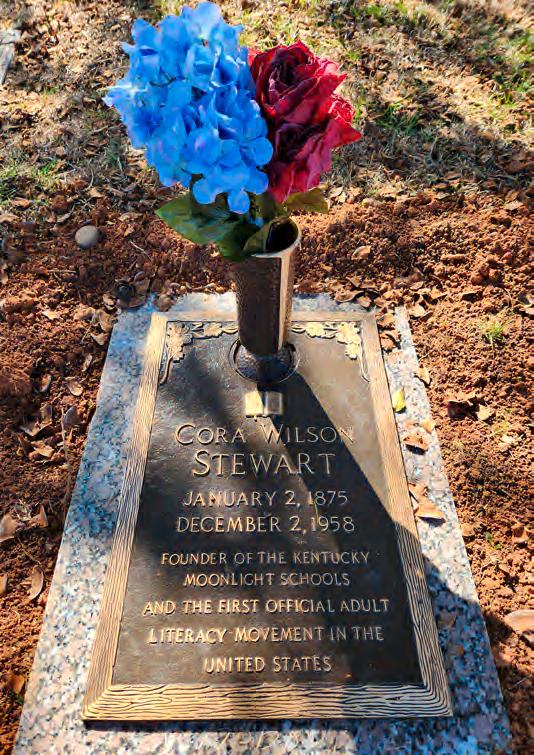
Cora Wilson Stewart’s new grave marker in Polk Memorial Gardens in Columbus, North Carolina, was designed by Kim Michele Richardson.
Home
to somehow right another sister’s legacy, and although Cora’s cemetery doesn’t allow standing headstones, I purchased a large decorative marker with vase and etched book that recognizes her priceless contribution to the world.
As a Kentucky author with a deep love for educators and the written word, I knew Cora needed a proper grave marker that recognized her lifelong battle to stamp out illiteracy. She called it, “a war without the loss of human blood, without the click of a gun or the firing of a cannon—a war fought with the book and pen.”
For many it was the war of one brave woman with an unwavering, crusading spirit who was no doubt doing the work of a five-star general.
Kim Michele Richardson is the award-winning author of The Book Woman of Troublesome Creek series, and founder of Shy Rabbit, a writers residency scholarship that promotes underserved artists. She is a native-born Kentuckian who resides in Kentucky.
In 2021, northern Kentucky businessman and amateur archaeologist Dennis Vesper purchased land adjacent to Blue Licks Battlefield State Resort Park. He knew that the property, almost all reverted to overgrown fields, had been the site of a mineral spring to which health seekers had flocked since the late 18th century. In fact, he realized that adjacent to the spring elegant hotels had arisen, and each in their turn had burned down. But most importantly, he knew that after the mineral spring dried up in 1896, efforts to locate a new vein of medicinal water resulted not in pinpointing more water, but in uncovering astonishing archaeological finds that would, if he and his colleagues could authenticate their discoveries, rewrite history.




Vesper, an archaeologist by avocation, often worked with Dr. Michael Gramly, a Harvard-educated doctor of philosophy in archaeology of considerable note who resides in North Andover, Massachusetts. Among Gramly’s numerous major discoveries are the Bowser Road Mastodon in Orange County, New York, in 2017, as well as the ivory Mastodon tusks at the Hiscock, New York, archaeological site he identified in 2014. He recognized that those tusks had served as sled runners, evidence that indicates humans’ presence in North America far earlier than had been thought to be the case.


In 2021, while perusing archaeological artifacts in the Pioneer Museum in the Blue Licks Battleground Resort Park adjacent to Vesper’s property, Vesper had spied an ivory sled runner that reminded him of the sled runners found at the Hiscock site where he had worked with Gramly. Some months later, Gramly visited Vesper at Lower Blue Lick so that by appointment with the museum curator the two men could examine the sled runner unearthed in the late 1890s by local farmer T.W. Hunter, who had been hired by the resort owners to find a new vein for the by then dried-up Blue Lick mineral spring. Upon seeing the runner and realizing the merit of Vesper’s conjecture, Gramly confirmed the find and asked the curator whether there were additional mastodon bones in the Pioneer Museum. To the men’s astonishment, there were five additional ivory sled runners, accompanied by cross members made of bone, all which Hunter had uncovered more than a century before from what is now Vesper’s property. After receiving permission from the State of Kentucky and the Kentucky Department of Parks to carbon test samples from the sled runners for the purpose of dating them, Gramly raised funds to do so through private donations. He also identified the Center for Applied Isotope Studies at the
Dr. Mike Gramly recording the attributes of one of six proboscidean sculptures carved from a mastodon’s third molar found at Lower Blue Lick, November 2023.
University of Georgia as the institution best suited to date not only bones and ivory but the collogen within them, as well as to gauge other age-related information. Results prove that the Lower Blue Lick sled runners are between 14,840 and 15,040 years old, rendering the Pioneer Museum sled, according to Gramly in Volume 15, Issue 5 of Pleistocene Coalition News “oldest, absolutely dated artifact in North America and certainly the oldest sled in the world.” In his article, Gramly suggests that a logical follow-up question might be whether the sled is also “the oldest directly dated artifact in the Western Hemisphere.” The answer, he writes, is that it may be, but until a “series of wooden artifacts” in southern Chile that have been assigned carbon dates are calibrated, the jury remains out regarding a definitive answer to that question.
To add perspective to Gramly and Vesper’s find, as well as to their even more recent discoveries, a bit more background follows. Late in the eighteenth century, before Kentucky became a state in 1792, newcomers to the northern Kentucky area between the Bluegrass and Licking River regions now known as Robertson County—such as Christopher Gist, followed by Daniel Boone and Simon Kenton— realized what long-time Native American residents of the region already knew: the saline-sulfur mineral spring at Blue Lick exhibited curative properties so great that word of its increasingly august reputation as a valuable source of healing water spread. Indeed, the region’s rich history includes the vicinity serving as the site of the last battle of the American Revolution in Kentucky, the Battle of Blue Licks in which Boone’s son Israel and dozens of other men died. Nearby, a significant salt lick to which animals flocked benefited people hunting animals for food and pioneers carving their roads from paths cleared by mammal-made passages.



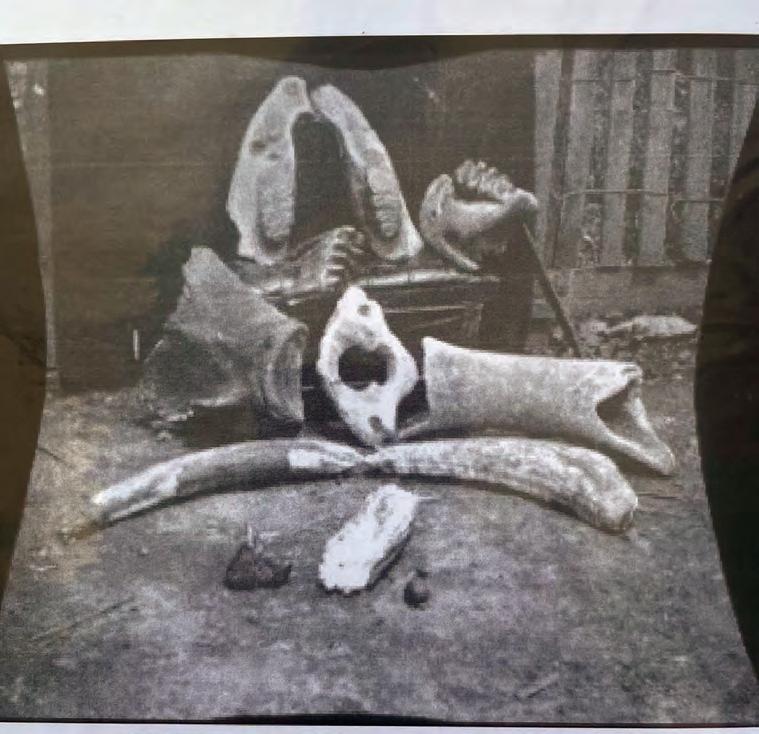

While in search of a new water source, T.W. Hunter discovered the skeletal remains of deer, elk, buffaloes, and mastodons. Photo courtesy of Randy Hunter

Over the decades, as became the practice of other mineral springs in Kentucky and beyond, eager entrepreneurs raised the bar for attracting well-heeled guests from their own and surrounding states to take the waters and engage with their social peers. In 1845 the Blue Licks Springs Company replaced previous spring accommodations with an elegant three-story hotel, The Arlington, that could house several hundred guests simultaneously until it burned by arson in 1862. The Western Military Institute then transferred its home in Georgetown to the grounds of Blue Lick Spring before relocating to Drennon Springs. However, in the last years of the nineteenth century, the spring started to dry up. And so, the company hired local farmer Thomas W. (T.W.) Hunter to locate a new vein of mineral water, a task he conducted during the autumn of 1897. Were he to succeed in uncovering more mineral water, his reward would be $500, a stipend not to be sneezed at in an era when the purchasing power of $500 was closer to what would be $20,000 today. On the day before All Hallow’s Eve, his digging at the site of the principal spring-pool on Springs Property grounds turned up shovels full of curiosities. Indeed, instead of locating a new stream of water, Hunter encountered a plentiful pile
of bones—skeletal remains of deer, elk, and buffalo —as well as the prehistoric bones of a mastodon— relics sufficient in number to top off two wagons. But not having achieved his goal of locating more water, Hunter dug further. Beneath the bones he uncovered an ancient limestone walkway upon which the mammal bones rested, an apparently manmade pavement carved with markings resembling characters and letters. Was Hunter’s discovery proof that the spring’s surroundings had been inhabited by humans long before historians and archaeologists had thought was the case?
Hunter only half realized the significance of the find he proceeded to excavate—the pavement along with the mammal bones he cast into his farm carts. His employers, who rated Hunter’s discovery as being almost without merit, no doubt thought themselves generous when they gifted him his skeletal discoveries in lieu of monetary compensation. After all, he had not uncovered what he set out to find.
However, Hunter proved as entrepreneurial as his Blue Lick employers. Although he did not possess the credentials of even a primitively educated archaeologist or historian, his quick intellect and curious spirit coupled with his ability to cater to people’s interest in wonderous discoveries provided him with the impetus to convert his consolation collection of bones into a traveling exhibit he conveyed to local fairs where he displayed his novelties and lectured about his finds. Hunter stored his limestone pavement in his cellar where in subsequent decades,
to Hunter’s dismay, his sons ground them up, repurposing them to create a new driveway.
Although Blue Lick Springs remained in operation until 1919, Springs owners had discovered no new vein to replace the mineral spring that had evaporated in the 1890s, a loss that coupled with their razed accommodations resulted in their abandonment of the resort. However, former Kentucky deputy commissioner of geology, then state archaeologist, Willard Rouse Jillson and his colleagues initiated intermittent digs in the 1940s and 1950s, recovering more mastodon bones, but uncovering no remnants of a walkway. Although Jillson recorded his mid-20th century finds, according to Gramly, those artifacts have since disappeared.
According to Maysville Ledger Independent contributor
Robert Roe in his 2022 online column “The Blue Licks Springs Walkway—Hopes of Discovery Crushed. Literally,” little more transpired on the property until 1965 when three Keene State College students in New Hampshire read about the elusive Blue Lick walkway and deemed it a promising topic for a term paper. Specifically, Roe writes, an article by W. L. Vallette, “Is America the Birthplace of Man?” that cited the Blue Lick walkway along with another, somewhat similar floor found in Colorado, sparked



their interest, especially as Vallette posited that the walkway must have been constructed in the Pleistocene period, probably 11,700 years ago, if not earlier. The students contacted newspapers throughout Kentucky, soliciting information regarding the limestone steps. Roe notes that all journalists who replied agreed that the walkway had existed. Their only disagreement focused on whether the steps had been manmade. That a civilization might have existed on and around the site of Lower Blue Lick Spring far earlier than experts had thought excited the students, as well as their instructor. However, although the eager scholars’ research renewed interest in the Lower Blue Lick discoveries, without further evidence of the walkway and without ongoing archaeological research, the site’s allure diminished.
At this point in the story, it is crucial to shift back to Vesper and Gramly’s revelations concerning the age of the sled in the Blue Lick Pioneer Museum. As mentioned earlier, Vesper’s obsession with Kentucky history bit him as a youngster and has remained with him all his life, rendering his purchase of the land on which the mastodon bones and tusks, as well as the limestone walkway, essential to the arc of the men’s discovery. In addition, Gramly’s earlier identification of a complete late Pleistocene,





Upper Paleolithic sled in situ (in its original place and position) near another mineral spring at the Hiscock archaeological site in Genesee County in western New York State had enabled him to see that the sled’s weightiest pair of runners were attached at the center of the sled to permit the transport of heavy loads. The sled’s smaller runners both lengthened the sled and eased its travel over ice and snow. As Gramly notes in his 2022 article, “Oldest Absolutely-dated Sled in the World” published in Volume 14, Issue 6 of the Pleistocene Coalition News, a significant difference between the Lower Blue Lick and the Hiscock site sled is that the Lower Blue Lick sled includes “cross-members made from proboscidean bone” which are “cleverly made” sections fashioned from femurs and pelvis to serve as “stout stabilizers.” In another article, “Late Pleistocene, Upper Paleolithic Sleds from Eastern North America,” published in volume 127 (April-June 2023) of the scientific journal L’Anthropologie, Gramly and co-author James B. Harrod posit that both the Hiscock and Lower Blue Lick sleds were assembled to serve as hearses. The authors describe the vehicles as “heavy sleds made of proboscidean ivory and bone,” assembled from “ritual kills of mastodons and mammoths or scavenged from skeletons of proboscideans [that] died naturally.”
Gramly and his colleague’s conclusion that transporting the dead served as the sleds’ purpose originated with additional evidence unearthed at the Hiscock site where, near the sled, lay a largely intact skeleton of a dog that exhibited “butchering marks.” According to Gramly, the dog had probably been sacrificed for the purpose of accompanying a culturally significant soul, no doubt a deceased shaman, to the spirit world. Sleds built for daily use of the living, notes Gramly, were constructed of wood.
Both in conversation and in his publications, Gramly stresses his strong conviction that such conveyances as sleds and such loyal companions as dogs permitted “tribal groups, who were coping with the extinction of mammals in the Old World, a chance to move ever eastward in search of vibrant populations of proboscideans.” He adds, “periodic interactions with mammoths, mastodons, and kindred species … [were] a focus of Gravettian [Upper Paleolithic European culture’s] socio-religious practices.” Indeed, Gramly asserts his intention of conducting further assessments at sites of significant mineral springs because, he writes, “Our search for portals to the Underworld at important mineral springs, which may have been used routinely by immigrant groups for sled burials, will continue. This hypothetical model of ancient human behavior and beliefs involving sleds—where climatic conditions permitted—will gain strength with fresh discoveries and dating evidence.”
Even as Gramly and Vesper’s dating of the sled at Lower Blue Lick has amended the historical record regarding the timeline in which humans migrated to the Western Hemisphere via the Bering Strait, revelations at the site continue to emerge. In late spring of 2023, Gramly led a dig on Vesper’s property that uncovered elegantly constructed steps. What’s more, the site of the longlost principal Blue Lick spring has been rediscovered, albeit not yet uncovered. In addition, while examining a handful of loose proboscidean teeth in the Pioneer Museum, Gramly realized that approximately 15,000 years ago humans painstakingly carved sculptures of proboscideans from mastodons’ largest molars. That he has identified a total of six proboscidean figurines in the Pioneer Museum alone is, as it were, jaw dropping or, as Gramly himself states, “totally amazing!”
In the same issue of Pleistocene Coalition News noted previously, Gramly considers the significance of this unexpected artistic and cultural find. “Proboscideans of the New World, whatever the species, must have been venerated and ritually important,” he writes. “This essential truth was first taught us by discoveries at the Bowser Road Mastodon site in New York State and is being retaught by our continuing fieldwork at Lower Blue Lick, Kentucky.”
And so, with each exhilarating discovery, relics recovered at bucolic Blue Lick continue to unravel and revise the trajectory of human history, of people in search of sustenance trailing proboscideans’ paths to survival.
Dr. Linda Elisabeth LaPinta has authored hundreds of magazine and newspaper articles, journal articles, and book reviews, as well as five books published by the University Press of Kentucky. Her most recent book, Kentucky Quilts and Quiltmakers: Three Centuries of Creativity, Community, and Commerce, is the recipient of the Popular Culture Association’s 2024 Emily Toth Award for best single work by one or more authors in Women’s Studies.

24 Kentucky humanities
Courtesy of Randy Hunter“R
ubbing a horse in the face will cause him to present his head to you, and talking kindly to him will attract his attention.” “[In] some horses it is important to whisper to them…you may use any word you please but be constant in your tone of voice.” These were the words of Kentuckian Denton Offutt, America’s first “horse whisperer.”
In his day, many considered him something of a con man, a type of wandering horse tamer. But Henry Clay and some of the most influential horsemen of the country, praised his amazing abilities with horses.
Denton Offutt was born on Hickman Creek, near where Fayette and Jessamine counties meet. The exact year of his birth is unknown, but sometime between 1804 and 1807 is a fair guess. As he grew, he joined his father and brothers in the livestock and river trade business. Upon his father’s death with his share of the inheritance in hand Denton set off for Illinois to test his luck. History tells us he owned and operated a small mercantile in New Salem, Illinois. It was at this point that he met Abe Lincoln and offered the future president a job running his store. It appears from that point on, the two remained friends. Offutt was not portrayed in flattering terms in physical appearance nor in terms of character: he was described as “garrulous, bibulous, short, rather stockily built man, of good-natured, amiable disposition, free handed…a trader and speculator who always had his eyes open to the main chance.” To Lincoln’s friends, he was “wild, reckless, unsteady, noisy, fussy, [and] rattlebrained.” A sheriff, from whose jail Offutt escaped in 1834, addressed his character as such: “very talkative and wishing to pass for a gentleman…was something of a confidence man, peddling a magical expression that
would allegedly tame horses when whispered into their ears.” This last statement would prove true. But little focus has been put on his life as a horse whisperer; instead, history dwells on his life as a merchant and his relationship with a young Abe Lincoln. So much so that his early store in New Salem, Illinois, has been preserved with other Lincoln historical objects.
During Offutt’s time, the typical way to train a horse was through what is known as “breaking” the animal. The term “breaking” brings forth the vision of violence. And rightly so, as the normal course of events in training a horse included instilling fear in the animal through the threat of pain. In watching old westerns on the television or at the movies one, is treated to the scenario of a cowboy riding a bucking bronco; after the cowboy has been thrown from the saddle a number of times the horse is “broke.”
Doesn’t sound so bad for the animal, but, in real life, a trainer might


turn to thrashing the horse in an effort to make it more docile.
However, this forceful type of training did not sit well with Denton Offutt. He preferred to speak in soft tones, often no more than a whisper into the ear of the horse to elicit docile results in the equine beast. Denton established and coached a distinctive approach to training a horse through a method he described as “gentling” rather than “breaking” a horse.


Fresh from escaping the law and creditors in Illinois, Offutt returned to Kentucky. Investing his time in “gentling” horses owned by his brothers Otha and Samuel, he transported their steeds from their farms in the Bluegrass region, to market. It was in 1840 that Denton began his line of business in earnest as a horse trainer. In contrast to other horse trainers in Kentucky, Offutt wasn’t concerned with only working with Kentucky thoroughbreds, but training all manner of horses, whether they be draft horses, horses

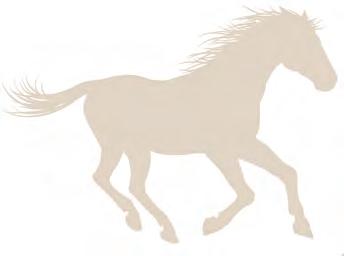
drawing any form of wheeled conveyance; horses trained for the saddle, and horses to ride herd. Sometime during his career, he even traveled to Georgia to train horses for a circus. He was particularly recognized for training horses fearful of the human touch. These included young horses not yet familiar with the saddle, feral horses roaming free on the open range, and what are today known as backyard ponies that have developed bad habits due to ill-treatment or neglect. A year into his new career, Denton offered a letter to a sporting publication, The Spirit of the Times, describing his thinking and methods in training horses. He voiced that “My secret for Taming Vicious Horses is gentleness and patience, which removes fear and gives the animal confidence in man.”
In 1842, Denton expounded further on the techniques written down in the missive he sent off in 1841, again to The Spirit of the Times. He titled his new pamphlet Denton Offutt’s Method of Gentling Horses and Curing Their Diseases. Offutt advertised this publication by a broadside printed in Washington, D.C. in 1843. Within the pamphlet’s pages, a number of horsemen in Kentucky, as well as a number in other states, gladly furnished their endorsements of Offutt’s equine knowledge. Five years, later his pamphlet morphed into a full-scale tome, A New and Complete System of Teaching the Horse on Phrenological Principles. This was followed by an April 1853 broadside issued by him, wherein he sought subscriptions for even a larger volume, detailing his whispering methods and more. Possibly, lacking funds for this new endeavor, he stated that “The work will be published as soon as a sufficient number of subscribers have been obtained to justify it, and on a large clear print, and well bound in cloth . . . [it will be] offered to subscribers at the moderate price of $5.” This advertisement could be found in numerous agricultural publications.
In March 1854, this new periodical was published as The Educated Horse. Within its pages, he describes in simple terms how to prevent a horse from balking at crossing over a bridge, how to accustom a horse to the sound of a gun being fired, how to ready the animal for the battlefield, and how to teach horses to travel at ease by rail or sail. Add to these few a large number of other training scenarios. And it wasn’t only horses he directed his gentling to, but mules and cows as well.
Continuing with this same volume, Offutt states that “the language of the horse is proven to all well-observing gentlemen, yet their signs are so simple as never to mistake each other. His language is so easily learned, so far as we are concerned, and we need it daily for the purpose of knowing the designs of the horse….” Keeping with this train of thought, Offutt devotes a chapter from The Educated Horse, titled “Dialogue between Man and Horse,” which represents the viewpoint of the horse in dealings with human caregivers. It also offers one an example of how that dialogue might progress to those taking the time to absorb Offutt’s teachings:
Horse — “When you wish me to get on a bridge, ice, or in a boat, or into a strange stable or narrow walk, how will you “Denton Offutt at once became the man of business. He brushed his best coat, buffed his hat, shined his boots, and bustled off.”
Thomas Hart Benton
manage to accomplish your design?”
Man — “I will go before you and show you the best way….”
In another scenario:
Man — “Why do you pull back when I go into your stall?”
Horse — “I am fearful of you, if you will put your hand on the hip before you come in, and let me know you will not hurt me, I will stand.”


Within this volume, Offutt delves deeply into the diseases afflicting the horse, and the cures needed to treat the various equestrian maladies.
What is surprising to know is that with all his publications, Offutt himself at best was semi-literate. This is apparent when one looks at a letter, he submitted to The Spirit of the Times in 1859. The letter was deficient in punctuation and the strange spelling and grammatical misplays made the letter almost too jumbled to make sense of. With this in mind, Offutt clearly must have relied on a person or persons with more educational acumen to write his pamphlet and other renderings. But whoever that co-writer is, it is lost to time.
Endorsements followed over the years. Many appreciative clients touted Denton Offutt’s achievements, which he included in the 1843 and 1853 broadsides. One testimonial especially stood out. It was drafted in 1849 by famed Kentucky political figure Henry Clay, and reads in part “Mr. Denton Offutt, of Kentucky…. I take great pleasure in recommending him as a person of uncommon skill in the treatment of horses…. Such is the extraordinary effect of his system in the management of the horse, that he will, in a very short time, render the wildest animal gentle and docile, insomuch that he will subject it to his easy control and direction. Mr. Offutt has been many years engaged in the study and practice of his remarkable method of dealing with the horse and has given many satisfactory evidences of his great success.”
One who studied under Offutt was John S. Rarey. Upon completing Offutt’s training in gentling horses, Raney was given a copy of Offutt’s book and pledged at no time to disclose Offutt’s secrets. But Raney did not honor the bargain, as other students such as Texas statesman Sam Houston, thrice-elected Virginia Congressman John Minor Botts, and celebrated Georgetown, Kentucky, horse breeder Keene Richards, who as a young teenager, began his tutelage under Offutt. This is but a truncated snippet of a much longer list of the Kentucky horse whisperer’s students.
Rarey continued to be a thorn in Offutt’s side. Crossing the Atlantic to the English shores, Rarey held the audiences spellbound with his equine demonstrations. He rose to the level of super-star, all the while hobnobbing with the elite. His name was on everybody’s lips. Leaving Europe with his newly gained wealth he was met on arrival in the United States with celebration. This was in sharp contrast to Offutt’s welcome in England:0 “Who is this Offutt?” “Never heard of him.” “Does
he even exist?” This was all too much for Denton to abide. He felt Rarey was guilty of making the secrets known to the general public, secrets he had vowed not to disclose. Offutt also made the charge that Rarey plagiarized his work and published it as his own. In 1859, Offutt sent a number of angry letters off to The Spirit of the Times that started with the following, “To people a warning against swindlers in teaching the art of training horse, selling a book.” The contents of the letters showcased his deficiencies in grammar and spelling. Offutt was cognizant of his grammatical inadequacies; so much so that he asked the publication to edit his letter. For some reason (was it out of cruelty or some other reason?), the periodical declined Offutt’s plea and ran the treatise precisely as Offutt had submitted it. The original letter read in part; [Rarey] was “not smart enough has changed and in every leson maid it wors.” Rarey was guilty of “Robing my coppy right,” “He wold not show it I compard it to many all say he is copped from mind I publickly declared him a Rober to his fase and Advertst him with the bove, Rober, swindler and Ignorant.” Offutt



had reached the boiling point. In January 1861, Offutt brought suit against Rarey for breaking his bond and stealing his work. But Offutt’s efforts failed as the suit was dismissed. Although the court found Rarey innocent of plagiarizing Offutt’s work, Rarey gave no reference to learning his gentling technique, which at times behind the scenes was not all that benign, under the tutelage of Offutt.



Denton Offutt to Abraham Lincoln, September 07, 1859, with a printed advertisement on the phrenology of animals complete with testimonials addressing Offutt’s skill with horses.

As a “horse whisperer,” Offutt definitely was the genuine article, as he certainly appreciated the art of gentling horses. But a number of characteristics certainly worked against him in gaining the celebrity status and the substantial financial gain he sought. His deficiencies with syntax and spelling proved detrimental to his career; his incessant obsession with Rarey’s using his techniques soured many on his claims. To those who never witnessed his exhibitions and read his writings (which were most likely ghostwritten), he seemed to suffer from hoof and mouth disease, as to some onlookers he seemed to put his foot in his mouth with his remarkable claims.
As Offutt’s reputation suffered at the hands of Rarey’s celebrity during his lifetime, in death he finally received the kudos he deserved. Offutt was the earliest known individual to devise and put pen to paper, sharing an approach based on gentle handling, rather than brute force used in training horses. Offutt’s legacy may be found in the efforts of modern trainers, who have re-placed the whip with a soft touch and a whisper, just as Offutt prescribed. History may not have been particularly kind to Denton Offutt, but for his horse sense, this man from Kentucky merits to be remembered as America’s first “horse whisperer.”
With a master’s degree in regional planning from the University of Massachusetts, David McCormick was employed by the City of Springfield, Massachusetts, for several years. Now retired, he works as a freelance writer. His articles have appeared in, Army Magazine, Michigan History, Naval History, and Pennsylvania Heritage, among others.
Edouard Aldahdah, “Keene Richards’ Arabian Horse Importation to the USA,” October 14, 2008. https://daughterofthewind.org/keene-richards-arabian-horse-importation-to-the-usa/.
Gary O’Dell, “Denton Offutt of Kentucky: America’s First ‘Horse Whisperer’?” Register of the Kentucky Historical Society, January 2010: 571-610.
“Horses Willful, Same as Children,” New York Herald, April 11, 1920, 33.
Michael Burlingame, “Separated from His Father, He Studied English Grammar.” In Abraham Lincoln: A Life, Volume 1. (Baltimore: Johns Hopkins University Press, 2013), 181-182.
New Salem (1811-1834)
“News Item,” Louisville Daily Courier, November 21, 1850, 3.
“Offutt, Denton.” Papers of Abraham Lincoln Digital Library. https://papersofabrahamlincoln.org/documents?fulltext=&aut hor=Offutt%2C+Denton&recipient=&keyword=&type=&date=&earliest=&latest=&edition=true.
Denton Offutt, The Educated Horse: Teaching Horses and Other Animals to Obey at a Word, Sign, or Signal to Work or Ride; also, the Breeding of Animals, and Discovery in Animal Psychology: and the Improvement of Domestic Animals. Washington, March 1854, 12-31, 40, 41, 176-219.
“The Horse-Tamers in Court Mr. Offutt’s Suit Against Mr. Rarey,” New York Times, February 5, 1861.
“The Kentucky Horse Tamer,” Staunton Spectator, July 26, 1859.




This new reporting series from WKMS explores the real costs of housing, food, childcare and more in Western Kentucky.
Want to share your story?


Email us at msu.wkms@murraystate.edu

See the headlines, stream music, and more at wkms.org!


Askip down the hill from my family’s farm in Owen County, the four-room house at Natlee where Vice Admiral Willis A. Lee, Jr. was born in 1888 still stands, though barely. Abandoned, its history forgotten, the next strong wind may topple it.
Time also has taken a toll on Natlee’s 19th century ambitions. The mill that anchored the region, the distillery, post office, general stores, school, church, the neat corridor of houses—all are gone. Natlee doesn’t warrant a highway sign today.
Yet, Natlee once was a prototype of the American Dream, and that it produced a man who played an essential role in preserving our right to pursue happiness as a free people should not surprise even the most sophisticated. Indeed, the Admiral’s story rightly begins with his family’s quest of the American Dream on the Kentucky frontier.
The Admiral’s great-great-grandfather, William Lee, was living in what would later become Franklin County, Kentucky, as early as 1787 and probably earlier. After years of research, I am unable to verify much more. I am convinced that he was not the son of Washington’s attorney general, Charles Lee, as Owen County historian Houchens claimed, nor can I find any other close relationship to General Robert E. Lee.
However, the Admiral’s nieces say their older family members harbored a grudge against Daniel Boone over a long-ago broken
land deal. Could it be that William Lee was connected in some way to the Charles and John Lee who were with Boone at Boonesboro in 1775? Certainly, the Admiral—an Olympic marksman—would have felt a kinship, blood or not, with men who stood with Boone and survived on the frontier with their rifles.
William’s son, Joseph—born in Kentucky before statehood— made his way to Eagle Creek in Owen County where he found fertile, affordable land and enough waterpower to run a gristmill. There, the family prospered, and Lee’s mill became the center of the developing area. The mill passed to a son, Nat—who added a commercially successful distillery—and in time the crossroads became known as Natlee (Nat’ly).
Nat fathered 18 living children, among them the Admiral’s father, Willis A. Lee, Sr. who pushed opportunity further and became a country lawyer. When Lee Sr. was elected county judge in 1895, he moved his young family, including the seven-yearold future Admiral, from Natlee to the county seat 15 miles away at Owenton (population 1,014 in 1900). Lee Sr. would serve several terms as county judge and a stint in the state legislature.
In Owenton, the Lee family lived in a bigger house than at
Vice Admiral Willis A. Lee, Jr. was born in Natlee, Kentucky, and lived in this four-room home with his family until age 7.
Natlee, but it still sat on an unpaved street and lacked indoor plumbing. There, the boy—who would become a man many called a genius—led an unremarkable childhood. The stories that survive speak only of typical boyish pranks and his love of prowling around Owen County farmland with his rifle, hunting.
Yet he undoubtedly benefited from the upward mobility his family had achieved over the previous four generations in Kentucky. In 1900, many American children did not finish the eighth grade, and fewer than 10 percent graduated from high school. The future Admiral, however, received a classical education in elementary school at a private Owenton academy. When he graduated early from Owenton High School, Congressman South Trimble appointed him to the Naval Academy. At the age of 16 and two months, this Natlee native who’d never seen the ocean became the second youngest member of the 1904 entering class at Annapolis.
And so, the future Admiral, accompanied by his father, boarded the train at the tiny depot at nearby Sparta to take the long ride to Maryland. More than a century later, the metaphoric distance still remains vast between sparsely populated, rural, land-locked Owen County and the Naval Academy—one of America’s crown jewels. I can only imagine how the campus must have looked to the future admiral on his arrival, especially magnificent Bancroft Hall, the new state-of-the-art quarters where he would live.
But young Lee settled in quickly, and soon distinguished himself on the rifle team. By 1907, competing against more than 1,000 others, he took first place in both individual rifle and pistol competitions at the U.S. National Shooting Matches—the only marksman to ever do both in a single year—and drew accolades from President Teddy Roosevelt. Lee did this in spite of nearsightedness that rapidly grew worse during his teenage years.
In 1920, Lt. Commander Lee was selected to the U.S. Olympic Rifle Team. He was the only American to shoot in all 15 events— more events than any other Olympian, in any sport, ever has. He won five gold medals, one silver, and one bronze for the team—a single Olympic record that stood for 60 years and still stands for an American.
It’s Lee’s remarkable contributions to naval history—our history—however, that compel me to study his life. Oddly, in the decades since World War II, the import of his military achievements received scant attention from historians. Lee’s biographer, David Fuqua, believes that the Admiral’s uncommon modesty, his untimely death, and that he and his wife, Mabelle, had no children to promote his legacy, kept Lee from receiving attention equal to that given to others. Only in recent years have scholars begun to revisit the reach of this Natlee native’s brilliance.
Shortly before the war, Lee, by then a captain, was named assistant chief of staff for fleet readiness. Here, he plunged himself into learning and mastering the use of radar, a little understood new technology. Specifically, he honed the use of radar for direct fire, a pivotal breakthrough that enabled U.S. ships to fire at
the enemy with accuracy at night. Today, Lee is considered the pioneer of naval radar use.
Almost equally significant, Fuqua says, is the manner Lee hand-picked and trained the Readiness staff. Many went on to become flag officers themselves, and Lee’s intuition about people and detailed attention in training them became legendary. As Rear Admiral Evan White Yancey, who once served under Lee, wrote: “I had a genius watching over me.”
Lee was promoted to the rank of Rear Admiral in 1942. By then, the Japanese were winning the war in the Pacific. American attempts to turn back Admiral Kondo’s “Tokyo Express” had been unsuccessful, and numerous U.S. ships and thousands of men had been lost. Stopping the enemy at the island of Guadalcanal in November 1942 became a near last gasp effort to halt Japan’s sweep across the Pacific.
The complexities of the Guadalcanal battle are difficult to condense into a handful of words. But even a layperson like me can grasp the David versus Goliath gist of Lee’s standoff with Admiral Kondo’s fleet. As the fighting raged through the night, Lee’s battleship USS Washington was at last the only American destroyer or battleship left intact and functional. As historian Floyd Houston phrased it, “… at that moment, (Lee’s) Washington was the entire U. S. Pacific Fleet.” Seizing upon a brief Japanese blunder that revealed the location of Admiral Kondo’s flagship, Lee and his men—men he had meticulously trained to use radar to direct fire with uncanny accuracy—attacked and sank the Kirishima. Flummoxed and unaware that only one American vessel remained viable, the Japanese Admiral retreated with his fleet of 14 ships. Had Lee failed at Guadalcanal, some historians think the war in the Pacific would have been lost.
In 1944, Lee was promoted to vice admiral and was second in command to Fleet Admiral William Halsey at Formosa and Ryukyu. Ironically, tragically, Lee died of a heart attack on August 25, 1945—eight days before Japan surrendered.
Around Natlee, only a few of us are left who know the history of the old Lee house. No marker notes the birthplace of this American hero—not many here have even heard his name. And I’m only a keeper of local stories who realizes that the Admiral’s is too large, too complicated, for the likes of me to adequately tell. I must leave to scholars like Fuqua the work of analyzing Lee’s military brilliance. I, however, believe this man hewed from pioneer Kentucky stock may just have kept the American Dream afloat for people like me, born at Natlee, too.
Georgia Green Stamper is a Kentucky writer whose published works include Butter in the Morning and You Can Go Anywhere. Her newest book, Small Acreages, available from Shadelandhouse Modern Press, was Longlisted for the 2023 PENAmerica Art of the Essay Award.

